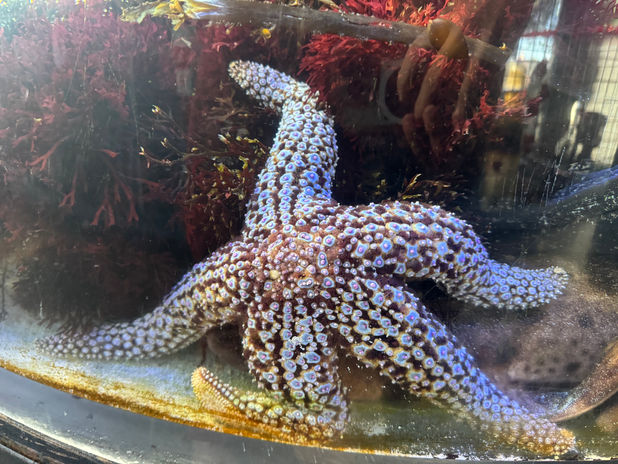Giant Sea Star
(Pisaster giganteus)
Population status in the wild: Least Concern
The Giant Sea Star, also known as the Mottled Sea Star or Giant Ochre Sea Star, is a large species of sea star native to the intertidal and subtidal zones along the Pacific coasts of North America, from Alaska down to Baja California. This sea star is known for its impressive size and striking coloration, which ranges from orange to purple, often with a mottled or spotted pattern across its thick, rough body. Its central disk is large, surrounded by five broad arms that can reach lengths of 24 inches, making it one of the largest sea stars in the world.
The Giant Sea Star is a predatory species, primarily feeding on bivalves such as clams, mussels, and oysters, as well as other slow-moving marine creatures. Using its tube feet, located on the underside of its arms, it pries open the shells of its prey and uses its stomach to externally digest the contents before absorbing the nutrients. This unique method of feeding makes the Giant Sea Star an important predator in intertidal ecosystems, helping control the populations of bivalves and other sessile invertebrates. In aquariums, they are typically fed bivalves or other marine invertebrates.
The Giant Sea Star is capable of regenerating lost arms, a feature common among sea stars. This ability to regrow limbs allows the species to recover from attacks by predators and environmental damage. In the wild, the Giant Sea Star can live up to 20 years, although many individuals only reach around 10 years of age due to predation and environmental factors.
Despite facing threats from habitat degradation and disease outbreaks, such as the sea star wasting disease, the Giant Sea Star is currently considered to have a stable population, and it remains of "Least Concern" according to the International Union for Conservation of Nature (IUCN).
Fun Facts:
The Giant Sea Star is often found in tidal pools and along rocky shorelines, where it plays a key role in maintaining the balance of the ecosystem by controlling populations of clams and other shellfish.
Despite its large size and impressive appearance, the Giant Sea Star is quite slow-moving, relying on its tube feet to move at a pace of just a few inches per minute.
Giant Sea Stars can reproduce both sexually and asexually, with females releasing millions of eggs that are fertilized externally. They can also regenerate entire new individuals from a single arm if the central disk is intact.
%20(1).jpg)

